Arrow Beer
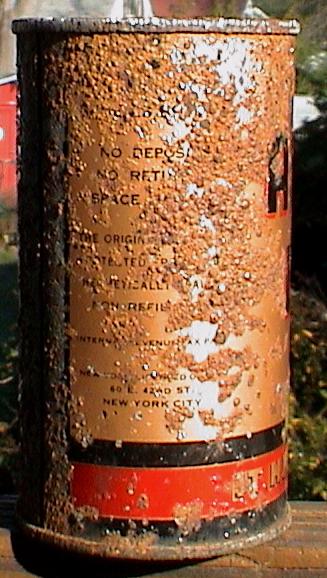 |
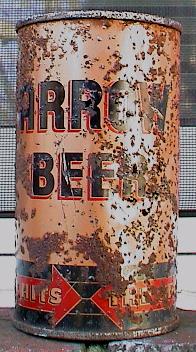 |
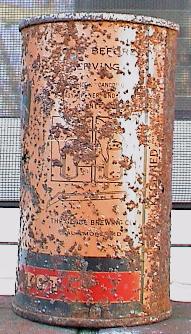 |
Arrow Beer, circa 1938-1942.
This is an Arrow Beer OI that I dumped in March 2002. It was a can-in-a-can, which means that whoever threw it out first stuck it inside a larger can. That protected it from rust to some extent, and it was one of the nicer Arrow cans to come out of that particular dump. Arrows don't hold up well in dumps as a rule, something about the paint properties causes them to come out of the ground in worse shape than other cans.
Globe Brewing
The Globe Brewery had a very long history, dating back to the founding of a brewery in 1748 by two brothers, John and Daniel Barnitz. Their brewery was built at what was later 327 S. Hanover Street. The brewery was built by a Captain Leonard using brinks imported from Britain. The brewery he built was still being used 200 years later when this month's Can-of-the-Month was brewed. While the brewing equipment had been updated many times, the same brick vaults were there from 1748. The brewery underwent many changes of ownership over 200 years (see the list below).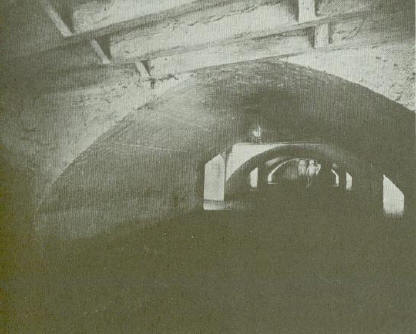 The original vaults, built 1744.
The original vaults, built 1744.The brewery probably originally started making ale, but lager beer was added in the 1820s after Peter Gloninger took over the brewery. Gloninger was German and Germans tended to prefer lager beer to the Ale favored by the British and by Anglo-Americans. Gloninger called his company the Washington brewery because it stood at the end of a dirt road that lead to Washington, D.C. Gloninger operated the brewery for about 7 years, then it was sold and went through several other owners before being bought by Samuel Lucas.
Under Lucas the brewery had more success and was the 2d largest brewer in Baltimore making about 7,000 barrels of beer, porter and ale a year. Lucas died in 1856 and the brewery was taken over by Francis Dandelet. A Frenchman, Dandelet ran a dry goods store nearby until he bought the brewery. The new owner changed the name to the Baltimore Brewery. Mr. Dandelet's brewery continued through the Civil War producing a brown stout, a beer and a porter. He lived in a townhouse attached to the brewery. Sometime after the Civil War he apparently picked up some partners. According to Kelly's "Brewing in Maryland" the Baltimore city directories showed several other men listed as proprietors of the brewery even while Dandelet remained attached to the company. William D. English and Peter Dahme were listed as owners briefly until a John Butterfield took over about 1876. Butterfield hired his son-in-law, Frederick H. Gottlieb who remained with the brewery an an officer, the brewmaster and as a manger until 1901. Dandelet remained with his brewery in some capacity until his death in 1878.
Gottlieb was born about 1840 in Hungary and came to the US with his parents when he was about 12. He lived and worked in Wheeling, West Virginia when, in 1875, he went to work for Butterfield. In 1876 he married Butterfield's daughter and went to work at the brewery in Baltimore. In 1880 Gottlieb joined with a Herman Heinrich Hobelmann and Frederick Wehr to form the Wehr-Hobelmann-Gottlieb & Co which made barley and rye malt. The company razed the old brewery and built a new seven story malt plant, so from 1881 until 1888 the site saw the production of malt rather than the brewing of beer. In 1888 the company returned to brewing with a new addition. Why did they return to the former business? Perhaps there was too much competition for their malt business? Perhaps they realized that the old brewing business had been more profitable? For whatever reason, the company resumed brewing beer.
The new company was called the Globe Brewing Company, a name it kept thereafter. It had an initial capacity of 120,000 barrels a year but in 1888 produced 32,000 barrels and in 1896 made 56,000. In 1899 the Globe Brewery joined with 16 other Baltimore breweries to form the Maryland Brewing Company. The Maryland Brewing group was succeeded by the Gottlieb-Bauernschmidt-Straus in 1901. Under GBS, the Globe Brewery produced G-B-S Special as well as its established brands Goldbrau and Munich. By 1914 the Globe Brewery was the central office for the entire group.
Prohibition
Globe survived Prohibition by making a Near Beer. GBS had begun to break apart in 1919 in anticipation of national prohibition. A junk business, Boston Iron and Metal Company bought the Globe Brewery in November 1919 apparently for the scrap metal value of its equipment. Instead, the new owners decided to try their hands at brewing a drinkable near beer and in 1920 formed the The Globe Brewing & Manufacturing Company. The new company held a contest to name their new product and the winner was "Arrow Special--It Hits the Spot." All of the other breweries owned by GBS were turned into other uses, but Globe continued making beer, even if it did have less than 1/2 of 1 % alcohol by volume.
Arrow Beer was transformed from near beer into the real thing at 12:01 am April 7, 1933 when 3.2% beer was legalized. Over a thousand thirsty Baltimorians waited in a nice downtown hotel to taste the new beer. The brewmaster, John J. Fitzgerald, was especially happy as he could now produce the product he had been trained to make, real beer. He was the first Baltimore brewer to produce legal beer once Prohibition ended.
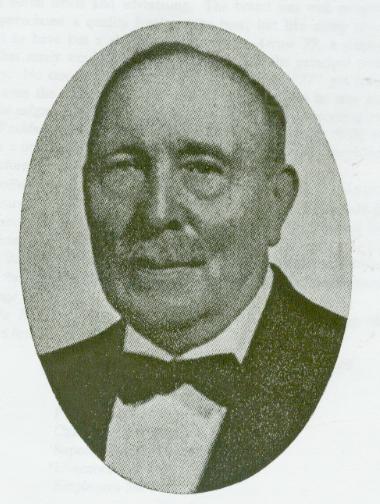 |
John J. Fitzgerald.
The plant quickly was expanded as beer sales grew. Capacity was increased to 225,000 barrels a year. New equipment was added, the cellars were expanded and new trucks were added to the delivery fleet. In July 1935 the company name was again changed, to the Globe Brewing Company. They produced Arrow Beer as well as Shamrock Ale as well as Arrow Ale and Arrow Bock.
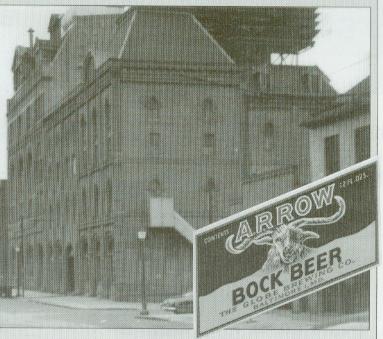 |
Globe Brewery, circa 1940s?
Post-Prohibition
After Prohibition Globe quickly shifted to making real beer, and became the first brewery to sell the genuine article. Globe first began canning their beer in 1936 producing several brands in cans including Arrow Ale, Arrow Beer, Shamrock Pale Ale, Hopfheiser, Eigenbrot's Ale and Eigenbrot's Beer. Only the Arrow Beer can is not rare. In 1940 due to increased demand the brewery expanded first its bottling department and then much of the rest of its plant. This month’s can-of-the-month was produced during this period of increasing growth.
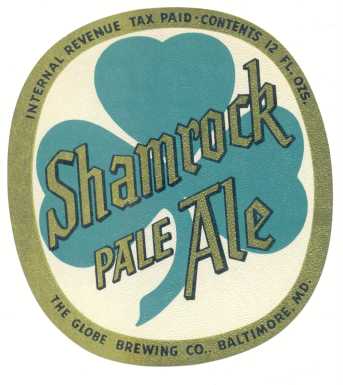 Shamrock label.
Shamrock label.
In 1944 Fitzgerald passed away and his assistant, Karl H. Henninge, who had earlier been with the Christian Heurich brewery in Washington, D.C., became brewmaster. Henninge discontinued brewing Arrow Ale and changed the formula for Arrow Beer. It had been “triple hopped” with a strong hops flavor. The new brewmaster made it less hop-flavored and into more of a lighter pilsner beer. The new formula was called “Imperial Lagered Arrow.” The new formula was very popular and in 1947 the brewery again expanded with a new four story brew house doubling the brewery’s output.
An Arrow Beer sign from the 1940s, with a cute puppy dog. 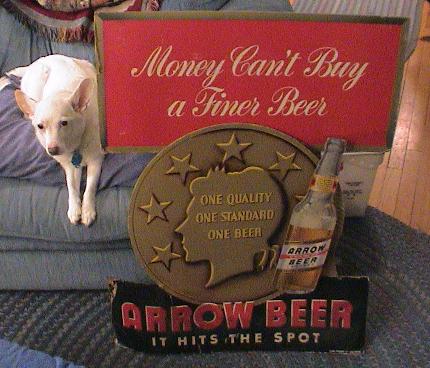
In 1948 Arrow decided to celebrate its “200th Anniversary” since the opening of the original brewery at the same location on Street. Newspaper advertising played up the theme and for a short while Arrow beer cans had a band across the top reading “200th Anniversary.” The brewery’s ads played up the local history in a bid to win customers through community pride.
 |
Arrow 200th Anniversary ad, click for full view.
In 1950 the can changed again, replacing the black “200th Anniversary” band on the top of the cans with a red band with the words “Imperial Lagered.” Both of these variations are somewhat scarce since they were produced for only a brief time. In 1951 the brewery again changed their design, moving to a dark can with a red oval logo on front featuring an old style carriage. They also began canning their bock beer at about this time.
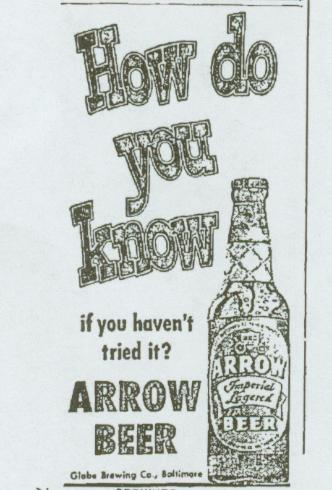 A small newspaper ad from August 1951.
A small newspaper ad from August 1951.
In 1952 Globe added a new brand of beer for the first time since Fitzgerald had been brewmaster. It was called Hals Beer, named after Dutch painter Franz Hals (1583-1666) and featured Hals’ famous painting the Laughing Cavalier on their labels. (This was the second time this painting was used on a can, beer brewed by Aztec Brewing in California used the painting on a conetop produced before World War II.) The beer, based on a Dutch recipe, was well received. Interestingly, the beer was produced by “Hals Brewing” in Baltimore. Usually a brewery only adopts a pseudonym for a new brand if the old company name had acquired a bad reputation. There is no indication I could find that Globe had gained a reputation for brewing bad or “cheap” beer. One suggestion they may have been having problems, however, is that their ads in the late 1940s often suggested people not “listen to experts” and try Arrow themselves. More research is needed on this question to determine if Globe created Hals to escape a poor reputation. Whatever their reason for creating it, Hals only lasted from 1952 until about 1959.
 |
Arrow "Experts" ad, click to see larger.
Arrow 77
In about 1955 Globe introduced a new name for their flagship brand, Arrow 77. No one seems to know where the 77 came from. Even the brewery secretary, when interviewed in the mid 1960s, did not remember why the 77 had been added. Perhaps it just sounded more “modern.” The company bowling team even took the same name. In 1962 a new beer was again attempted, McNamara’s Original Mac’s Beer, named after the brewery’s President, Francis D. McNamara. This beer was even shorter lived than Hals, and was never canned.On August 1 1963 production of Arrow 77 was shifted to Cumberland Brewing in Cumberland, Maryland. Production was stopped at Globe’s Baltimore plant and the old Globe Brewery became offices for distribution only. As a result, collectors can find Arrow 77 cans in both pull-tab and flat tops from both Baltimore and Cumberland. The newly reorganized company also took over distribution for Gunther Beer, now being produced by F.M. Schaefer in Baltimore.
The Cans of Globe Brewing.
Globe Brewing produced several cans during its post-Prohibition lifetime, a few common and several which are quite rare. The list below has all the variations of which I am aware. The rareness notes below are taken from Kevin Lilek's OI book, from the Rusty Bunch survey taken in 2001, and in the case of the more recent cans, from my personal dumping experience. More research is needed on my part to determine when Arrow 77 replaced Arrow Imperial Lager.Arrow Ale (1937-1938) two variations.
1. "English Style" (USBC 32-1). Very rare, maybe 6 known in all conditions?
2. (USBC 31-40) Rare, less than 10 known.
Arrow Beer (1937-1963) five variations.
1. OI, 1937, (USBC 32-2 or 3?) has Maryland Permit Number on side. tough in good condition but not rare.
2. OI, 1938-1942. (USBC 32-2 or 3?) tough in indoor condition, otherwise common. "patents pending" on side panel.
3. OI 1947-1948. (USBC 32-2 or 3?) common. Patent information on side different from #2.
4. OI 1948 (USBC 32-4) "200th Anniversary Can" semi tough in indoor condition.
QUESTION: did Arrow return to their regular can (#3) from 1948-1950 or use the 200th Anniversary can past 1948?)
5. non-OI. 1951-? (USBC 32-5) "Imperial Lagered" on red band at top. semi tough in indoor condition.
Arrow Imperial Lager (USBC 32-6) 1951-1959 (?) common.
Arrow Bock (USBC 32-90) semi-rare in any condition.
Arrow 77 (6 variations, 3 flats and pulls.)
1. 1959 (?)-1963 (USBC 32-7) from Baltimore, gold band at top and bottom. common.
2. 1959 (?)-1963 (USBC 32-8) from Baltimore, silver band at top and bottom, common.
3. 1959 (?)-1963 (USBC 32-10) from Cumberland. silver bands. common.
4. 1963 zip top from Baltimore. gold band. common
5. 1963 zip top from Baltimore. silver band. common
6. 1963 -1964 zip top from Cumberland. silver band. common.
Eigenbrot's Ale. 1935. (USBC 59-14) 2 variations.
1. 1935. OI. rare, less than a case known.
2. 1935 OI. the same as #1 but has the word "Canco" on side in quotation marks. Very rare, two known.
Eigenbrot's Beer. 1935. (USBC 59-15) 2 variations.
1. 1935. OI. rare, maybe 12 known.
2. 1935 OI. the same as #1 but has different canning number on side. Very rare, one indoor and 4 very poor dumpers known.
Hals: 1951-1959? (USBC 78-39) semi-tough. Not rare but not dumped often. Most collectors in the region where it was sold have a decent one, but it trades well outside of Globe Brewing’s old marketing area. I am basing the date range on ads for Hals in Maryland newspapers.
Hopfheiser 1936. (USBC 83-24). Very rare, 6 known. Only 1 is known in good indoor condition and it surfaced in 2001 in the collection of a former can company employee. Another indoor can is smoke-stained and also came from a can company employee. Four were dumped in 1990 in North Carolina, all were grade 3- to 4-.
Shamrock. 1938? (USBC 132-37) Rare, less than a case total known. Interestingly, all but one are indoor cans which came from a single find. Was this can only produced for only one production run?
Globe Brewing Name Changes
John Leonard Barnitz & Elias Daniel Barnitz (Baltimore & Hanover Sts) 1748-1749Elias Daniel Barnitz 1749-1780
John Hammond & Co. 1780-1794
John G. C. Barnitz 1794-1795
Thomas Kerr 1796-1809
(Captain) Joseph Leonard 1809-1816
(Captain) Joseph Leonard & Co. (Hanover, Conway & Perry Sts) 1816-1822
Peter Gloninger, Washington Brewery 1822-1827
Gloninger & Johnson, Washington Brewery 1827-1829
John Krouse, Washington Brewery 1829-1831
(Andrew) Graham & Silvey, Washington Brewery 1831-1832
Samuel Lucas, Washington Brewery 1832-1856
Francis Dandelet, Baltimore Brewery 1856-1871
F. Dandelet & Co. (John Butterfield & Wm. English) 1871-1875
English & Co. (Peter Dahme) 1875-1876
John Butterfield & Co. (Frederick Gottlieb) 1876-1880
Frederick Gottleib & Herman Hobelmann 1880-1881
(Frederick) Wehr-Hobelmann-Gottlieb & Co. 1881-1888
Wehr-Hobelmann-Gottlieb Brewing & Malting Co., Globe Brewery 1888-1899
Maryland Brewing Co., Globe Brewery 1899-1901
Gottlieb-Bauernschmidt-Straus Brewing Co., Globe Brewery 1901-1920
The Globe Brewing & Mfg. Co., aka: Globe Bottling & Sales Co.; Globe Brewery (313/327 South Hanover St) 1920-1935
The Globe Brewing Co., aka: Hals Brewing Co. (1958-1963) 1935-1963
Sources Used:
Beer Can Collectors of America. United States Beer Cans. (Beer Can Collectors of America: Fenton, Mo) .
Beer Can Collectors of America. Catalog of American Beer Cans. (1993).
Kelly, William J. Brewing in Maryland: From Colonial Times to the Present (1965). 132-151.
Lilek, Kevin C. United States Beer Cans with Opening Instructions (2004)
One Hundred Years Of Brewing (Chicago 1903) 436-437.
Thanks to Candog and Matt M. for the corrections!
